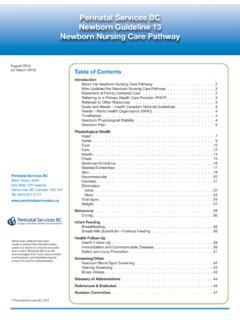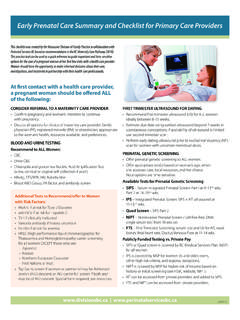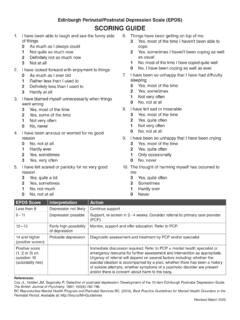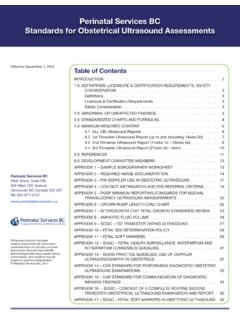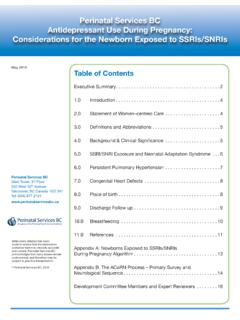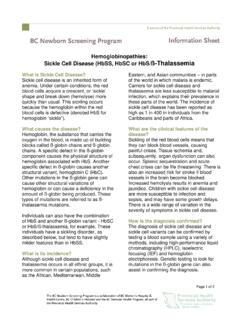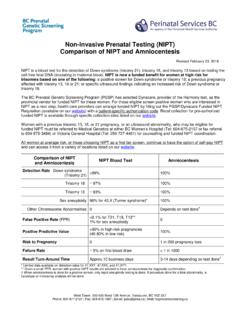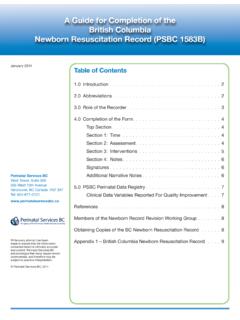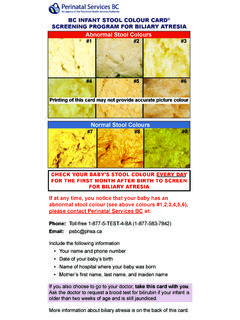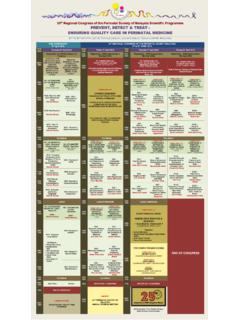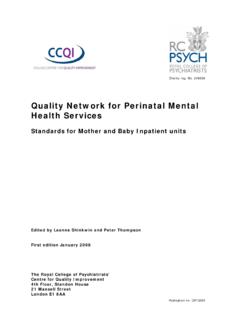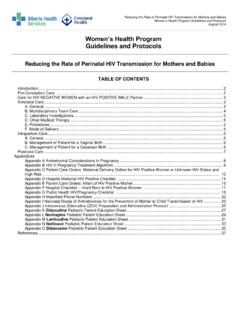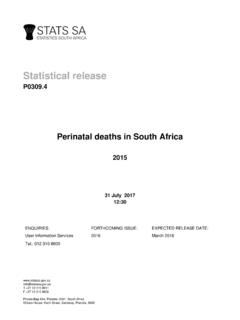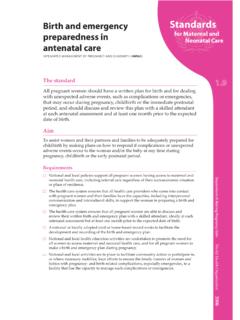Transcription of Standards for Neonatal Resuscitation: Perinatal …
1 While every attempt has been made to ensure that the information contained herein is clinically accurate and current, Perinatal Services BC acknowledges that many issues remain controversial, and therefore may be subject to practice interpretations. Perinatal Services BC, 2017 Perinatal Services BC West Tower, Suite 350 555 West 12th Avenue Vancouver, BC Canada V5Z 3X7 Tel: 2017 Perinatal Services BC: Provincial Perinatal Guidelines Standards for Neonatal ResuscitationContents1. Executive Summary .. 22. Introduction .. 33. Abbreviations .. 4 Definitions .. 44. Clinical Significance .. 5 Identification of Newborns at Risk .. 6 Neonatal resuscitation Practices .. 6 Documentation .. 14 Availability and Maintenance of Equipment, Supplies and Medications .. 145. Administration .. 15 Local / Regional / Health Authority Implementation of a Neonatal resuscitation Program .. 15 Provincial Neonatal resuscitation Advisory Committee .. 15 National NRP Steering Committee.
2 15 Canadian Paediatric Society (CPS).. 156. Ongoing Education and Training Programs .. 167. Special Considerations .. 17 Guiding Principles for Home Births and Non-Designated Perinatal Facilities 178. Clinical Performance Indicators .. 18 PSBC Perinatal Data Registry Clinical Data Variables .. 18 PSBC Perinatal Data Registry Reporting and Quality Improvement .. 189. References.. 18 Websites .. 18 Development Committee Members .. 19 Lead Authors Revision (2016) .. 19 Lead Authors (2014) .. 19 Reviewers (2016 / 2017) .. 19 Appendix 1: Neonatal resuscitation Supplies and Equipment Quick Check for Radiant Warmer .. 20 Appendix 2: Neonatal resuscitation Supplies and Equipment .. 21 Appendix 3: Individual Integrated Skills Station Assessment tool .. 23 Appendix 4: Neonatal resuscitation Algorithm .. 25 Appendix 5: Safe Skin to Skin Positioning .. 26 Appendix 6: ACoRN Respiratory Score .. 27 Appendix 7: British Columbia Newborn resuscitation Record .. 282 Perinatal Services BCApproximately 90% of newborns make a smooth transition from intrauterine to extrauterine life.
3 The remaining will require assistance to establish effective ventilation. Chest compressions and medications are rarely required (less than 1%).1 To facilitate Neonatal transition, anticipation and preparation help organize the appropriate healthcare team to deliver resuscitation as per the Neonatal resuscitation Program (NRP). On occasion, unanticipated difficulties at birth are The provision of timely, skilled assistance to a compromised newborn can impact a 7th Edition of the Neonatal resuscitation Textbook and Neonatal resuscitation Program (NRP) is based on the evidence presented by the neonatology subgroup of the International Liaison Committee on resuscitation (ILCOR). This edition has been updated with more evidence as new information became available reflecting the increasing number of research studies in Neonatal resuscitation practices. In addition, NRP reflects evidence based changes in learning methodology, with emphasis on communication, teamwork, simulation and debriefing.
4 A high standard of resuscitation skills, knowledge, communication and team work are following are key recommendations to support Neonatal resuscitation in British Columbia (BC). Facilities that offer planned Perinatal services must ensure their personnel are capable of Neonatal resuscitation , post- resuscitation assessment and All facilities must have an algorithm / plan outlining the provision of Neonatal resuscitation . In some facilities, the response team may include health care personnel from outside the usual Perinatal team ( , emergency room, anesthesia, medicine, surgery, respiratory). The roles and responsibilities of each responder must be clearly identified. In addition to the primary care provider responsible for attending to the mother, every birth should be attended by a second health care provider whose primary role is to assist the baby during transition, including the ability to provide positive pressure ventilation (PPV) and perform chest One person with the skills required to perform a complete resuscitation , including intubation and delivery of medications should be Teams should follow the principles of family centered care while resuscitating a baby.
5 Every attempt should be made during the antenatal period to identify at risk pregnancies to plan for additional Neonatal support or higher level of care . Practice changes introduced by the American Academy of Pediatrics (AAP) Neonatal resuscitation Program (NRP) and endorsed by the Canadian Paediatric Society (CPS) are to be implemented in order to provide evidence based Neonatal resuscitation . Standardized Neonatal resuscitation supplies and equipment should be present and functioning at all births (Appendix 1 and Appendix 2). Hospitals and / or regions should have interprofessional Neonatal resuscitation or Perinatal committees to provide leadership and direction for the maintenance of NRP national Standards . A team approach to education and training must be used to develop collaboration across professions and disciplines, including the definition of roles and responsibilities, scope of practice, improved teamwork, and enhanced Neonatal resuscitation workshops must include the following components: pre-reading of the Neonatal resuscitation Textbook, 7th Edition successful completion of the online examination prior to attending the workshop, participation in a skills development / validation station, successful completion of an individual integrated skills station, and participation in simulation / debriefing exercises (video recording recommended).
6 Each participant s knowledge and performance should be objectively evaluated using the online examination and Canadian Individual Integrated Skills Station Assessment Form Tool (Appendix 3). Interprofessional skills drills or mock codes should be performed regularly in sites with planned Perinatal services to highlight systems and educational Executive Summary3 Standards for Neonatal resuscitation The BC Provincial NRP Steering Committee recommends that Health Authorities support at least the initial and recurring every 2 years NRP renewal educational needs of the interprofessional team (including physicians, nurses, midwives, respiratory therapists and paramedics) to ensure that the current Neonatal resuscitation guiding principles and skills are consistently met. Midwives and physicians attending out-of-hospital births and staff in non-designated Perinatal facilities should be capable of providing initial Neonatal resuscitation , ongoing stabilization and planning for transfer.
7 Health Authorities should establish a method of supporting midwives and physicians attending out-of- hospital births and non-designated Perinatal sites with equipment and supplies required for Neonatal IntroductionThis document outlines the Standards for Neonatal resuscitation in BC. The clinical guidelines are described in the Neonatal resuscitation Textbook, 7th Edition, is an educational program primarily designed to teach the principles and techniques of resuscitation of babies undergoing transition to extrauterine life in a hospital, birth centre or home setting. These principles also apply to the resuscitation of babies during the time the baby remains in hospital following completion of NRP and registration with the CPS NRP database do not imply that an individual has the competence to perform Neonatal resuscitation . Professional regulating bodies, Health Authorities or individual hospitals are responsible for determining the level of competence and qualifications required to assume clinical responsibility for Neonatal ,2 Each facility should establish a standardized system by which each resuscitation is debriefed by the team to identify team knowledge and skill development needs along with system needs such as equipment, supply and policy Executive Summary.
8 Cont d4 Perinatal Services BCAAP American Academy of PediatricsACoRN Acute care of at-Risk NewbornsBC British ColumbiaBCPDR British Columbia Perinatal Data Registrybpm beats per minuteCPAP Continuous positive airway pressureCPS Canadian Paediatric SocietyETT Endotracheal tubeILCOR International Liaison Committee on ResuscitationIO IntraosseousIPPV Intermittent positive pressure ventilationLMA Laryngeal mask airwayNICU Neonatal Intensive care Unit NRP Neonatal resuscitation ProgramPEEP Peak end expiratory pressure PIP Peak inspiratory pressurePPV Positive pressure ventilationPSBC Perinatal Services of British ColumbiaUVC Umbilical venous catheterDefinitionsNeonate: Birth to 28 : Pertaining to the period immediately before and after birth. The Perinatal period is defined in diverse ways. Depending on the definition, it starts at the 20th to 28th week of gestation and ends 1 to 4 weeks after Abbreviations5 Standards for Neonatal resuscitation Facilities that offer planned Perinatal services must ensure their personnel are capable of Neonatal resuscitation , post- resuscitation assessment and stabilization.
9 All facilities must have an algorithm / plan outlining the provision of Neonatal resuscitation . In some facilities, the response team may include health care personnel from outside the usual Perinatal team ( , emergency room, anesthesia, medicine, surgery, respiratory). The roles and responsibilities of each responder must be clearly identified. In addition to the primary care provider responsible for attending to the mother, every birth should be attended by a second health care provider whose primary role is to assist the baby during transition, including the ability to provide positive pressure ventilation (PPV) and perform chest One person with the skills required to perform a complete resuscitation , including intubation and delivery of medications, should be Teams should follow the principles of family centered care while resuscitating a facilities where planned births occur must be resourced for Neonatal resuscitation training including renewal courses.
10 Healthcare professionals who attend these births must have current knowledge of Neonatal resuscitation and be capable of resuscitation , post- resuscitation assessment and initial stabilization.* Neonatal resuscitation is an area where a team approach to education and training is used to develop collaboration across is critical that personnel with NRP and teamwork skills be available for every birth. The size and composition of the multidisciplinary team will vary with designated level of care of the birth location and its birth from the healthcare professional responsible for the birth ( , the physician or midwife), a second healthcare professional should be present whose primary responsibility is the baby and is capable of performing the initial steps of Neonatal resuscitation , including effective ventilation and chest compressions. If this person cannot perform more extensive resuscitation (endotracheal intubation and administering medications), additional personnel with these skills should be available in the facility to assist immediately when ,2,3 A person should be identified to lead the resuscitation .
